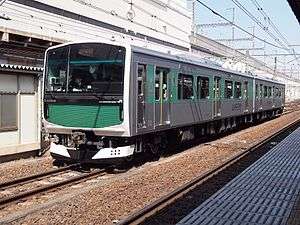EV-E301 series
| EV-E301 series | |
|---|---|
|
Set V1 on a test run in March 2014 | |
| In service | 15 March 2014 - |
| Manufacturer | J-TREC |
| Built at | Yokohama |
| Family name | Accum |
| Replaced | KiHa 40 series |
| Constructed | 2014 |
| Number built | 2 vehicles (1 set) |
| Number in service | 2 vehicles (1 set) |
| Formation | 2 cars per trainset |
| Fleet numbers | V1– |
| Capacity | 265 per set |
| Operator(s) | JR East |
| Depot(s) | Oyama |
| Line(s) served | Karasuyama Line, Tohoku Main Line |
| Specifications | |
| Car length | 20,000 mm (65 ft 7 in) |
| Width | 2,800 mm (9 ft 2 in) |
| Floor height | 1,130 mm (3 ft 8 in) |
| Doors | 3 pairs per side |
| Maximum speed |
65 km/h (40 mph) (service) 100 km/h (60 mph) (design) |
| Acceleration | 2.0 km/h/s |
| Deceleration | 3.6 km/h/s |
| Electric system(s) | 1,500 V DC |
| Current collection method | Overhead line |
| Bogies | DT79 (motored), TR255D (trailer) |
| Safety system(s) | ATS-P |
| Track gauge | 1,067 mm (3 ft 6 in) |
The EV-E301 series (EV-E301系) is a two-car battery electric multiple unit (BEMU) train type operated by East Japan Railway Company (JR East) on the Karasuyama Line and Tohoku Main Line since 15 March 2014.[1] The train is branded "Accum".[2]
Overview
Developed from the experimental "Smart Denchi-kun" battery railcar tested on the Karasuyama Line in 2012, the two-car EV-E301 series train operates as an electric multiple unit (EMU) under the 1,500 V DC overhead wire of the Tohoku Main Line between Utsunomiya and Hōshakuji, and on battery power over the 25.4 km (15.8 mi) non-electrified Karasuyama Line. It can also be recharged via its pantographs at a recharging facility specially built at Karasuyama Station.[2] JR East hopes ultimately to replace all of the diesel trains used on the line with these trains.[3]
The two-car trainset is equipped with 190 kWh lithium-ion storage batteries,[2] and the train has a maximum design speed of 100 km/h (60 mph), although it normally runs at up to 65 km/h (40 mph) in service.[4]
 Set V1 running under overhead wires on the Tohoku Line, March 2014
Set V1 running under overhead wires on the Tohoku Line, March 2014- Set V1 being recharged at Karasuyama Station, March 2014
Formation
The two-car train is formed as shown below, with car 1 at the Utsunomiya end.[2]
| Car No. | 1 | 2 |
|---|---|---|
| Designation | Mc' | Mc |
| Type | EV-E300 | EV-E301 |
| Weight (t) | 37.7 | 40.2 |
| Passenger capacity (seated/total) | 48/133 | 48/133 |
The Mc car has two PS38 single-arm pantographs.[2]
Interior
Internally, the train uses LED lighting throughout.[2] Seating accommodation consists of longitudinal bench seating.[2] The train is not equipped with a toilet.[4]
- Interior of car EV-E301-1
- Interior of car EV-E301-1
Bogies
Each car is mounted on a TR255D non-powered trailer bogie at the outer end, and a DT79 motored bogie at the inner end.[2]
- TR233D trailer bogie
- DT79 motor bogie
History
The first set, V1, was delivered from the Japan Transport Engineering Company (J-TREC) factory in Yokohama on 21 January 2014.[5] Test running commenced on 23 January, on the Utsunomiya Line, including running on battery power with the pantographs lowered.[6] It entered revenue service on the Karasuyama Line from the start of the revised timetable on 15 March 2014.[1]
In May 2015, the EV-E301 series was awarded the 2015 Laurel Prize, presented annually by the Japan Railfan Club.[7] A presentation ceremony was held at Karasuyama Station on 26 September 2015.[8]
See also
- Smart BEST, a self-charging BEMU train developed by Kinki Sharyo in 2012
- BEC819 series, an AC BEMU introduced by JR Kyushu in 2016
- EV-E801 series, an AC BEMU to be introduced by JR East on the Oga Line in spring 2017
References
| Wikimedia Commons has media related to JR East EV-E301. |
- 1 2 "烏山線でEV-E301系が営業運転を開始" [EV-E301 series enters revenue service on Karasuyama Line]. Japan Railfan Magazine Online (in Japanese). Japan: Koyusha Co., Ltd. 16 March 2014. Retrieved 17 March 2014.
- 1 2 3 4 5 6 7 8 "EV-E301系蓄電池駆動電車" [EV-E301 series battery EMU]. Japan Railfan Magazine. Vol. 54 no. 638. Japan: Koyusha Co., Ltd. June 2014. pp. 54–59.
- ↑ "JR東日本 烏山線に新型蓄電池電車導入" [JR East to introduce new battery train on Karasuyama Line]. Tetsudo Hobidas (in Japanese). Japan: Neko Publishing Co., Ltd. 6 November 2012. Retrieved 6 November 2012.
- 1 2 "烏山線用EV-E301系" [Karasuyama Line EV-E301 series]. Japan Railfan Magazine. Vol. 54 no. 636. Japan: Koyusha Co., Ltd. April 2014. pp. 62–64.
- ↑ "EV-E301系「ACCUM」が甲種輸送される" [EV-E301 series "Accum" delivered]. Japan Railfan Magazine Online (in Japanese). Japan: Koyusha Co., Ltd. 22 January 2014. Retrieved 22 January 2014.
- ↑ "EV-E301系「ACCUM」が宇都宮線で試運転" [EV-E301 series "Accum" test-run on the Utsunomiya Line]. Japan Railfan Magazine Online (in Japanese). Japan: Koyusha Co., Ltd. 24 January 2014. Retrieved 24 January 2014.
- ↑ ブルーリボン賞・ローレル賞 選定車両一覧 [Blue Ribbon Award & Laurel Prize Winner List] (in Japanese). Japan: Japan Railfan Club. 21 May 2015. Retrieved 21 May 2015.
- ↑ EV-E301系 ローレル賞を受賞 [EV-E301 series receives Laurel Prize]. RM News (in Japanese). Japan: Neko Publishing. 1 October 2015. Retrieved 1 October 2015.
